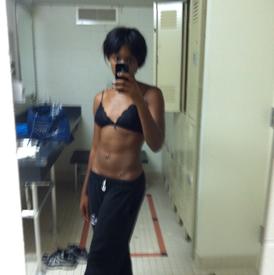Measurements/Weights 101

Mindful_Trent
Posts: 3,954 Member
Many people have trouble with the serving sizes, measuring their food, etc., because so many different types of measurements are used. Here's some basic info people might find helpful... I'm not going to list ALL possible conversions, but some of the main ones, for both metric and US systems. For anything I don't cover, Google is your friend!! :bigsmile:
VOLUME (how much space something takes up) - used for liquids or solids that are fairly consistent in size/shape, and with individual pieces that are fairly small - like rice, beans, flour - not mixed veggies, large chunky cereal, etc.:
1 cup is 16 Tablepoons (So 1/2 cup is 8 Tbsp, and 1/4 cup is 4 Tbsp)
1 cup is 240 ml
1 cup is 8 fluid ounces
1 Tablespoon is 15 ml
1 Tablespoon is 3 teaspoons
1 Liter = 1000 ml
1 Liter = 32 fl. ounces
1 Liter = 4.2 cups
1 Liter = .26 gallons
1 pint = 2 cups
1 quart = 2 pints (or 4 cups)
1 gallon = 4 quarts (or 16 cups)
WEIGHT (best for solids that aren't consistent in size/shape, hard to put in a measuring cup, etc. - like fruit, mixed veggies, meat, etc.)
1 kg = 1000 grams
1 pound = 453.59 grams
1 pound = 16 ounces
1 ounce = 28.35 grams
1 pound = 0.45 kg
1 kg = 2.2 pounds
1 stone = 14 pounds
1 stone = 6.35 kg
Note about OUNCES: It is a little confusing because there are fluid ounces and weight ounces. IF you are looking at a fluid, and it has something about ounces (often "fluid ounces" or "fl oz") - there are 8 fluid ounces in a cup. It is important NOT to mistake this for the WEIGHT ounces. Fluid ounces (volume - the space it takes up) and weight ounces are not the same. Any non-liquid that refers to ounces is referring to weight, not volume.
Note about Weight vs Volume - you cannot convert between weight and volume unless you know the denisity of the item you are looking at. 1 cup of lead pellets will not weigh the same as a cup of marshmallows! (An extreme example, but it makes the point.) Many food labels in the US provide volume and weight, which is nice - (Ex. 1 serving size of my oatmeal is 1/2 cup (volume) or 40g (weight). ) But if they're not both available, you'll have to go with whatever is provided.
Note about trying to use Volume for "chunky" things: It's much more accurate to weight things that don't fit neatly in measuring cups. You could measure out significantly different amounts of mixed fruit, for example, depending on how you cut it up. Same with mixed veggies, meat, etc. Kitchen food scales are not very expensive - I personally recommend this one - I've been using it over 2 years, and only changed the batteries once, plus it has a high weight limit (11 lbs) and is very easy to use, and has the tare function (good for weighing multiple things in one bowl) and can switch between pounds, grams, ounces and something else I can't remember (kg maybe?). (Note - it's got just about 5 stars with almost 2000 reviews on amazon... I'm not the only one who likes it!)
http://www.amazon.com/EatSmart-Precision-Pro-Multifunction-Capacity/dp/B001N0BBAY/ref=tag_tdp_ptcn_edpp_url/192-2746844-3599963
VOLUME (how much space something takes up) - used for liquids or solids that are fairly consistent in size/shape, and with individual pieces that are fairly small - like rice, beans, flour - not mixed veggies, large chunky cereal, etc.:
1 cup is 16 Tablepoons (So 1/2 cup is 8 Tbsp, and 1/4 cup is 4 Tbsp)
1 cup is 240 ml
1 cup is 8 fluid ounces
1 Tablespoon is 15 ml
1 Tablespoon is 3 teaspoons
1 Liter = 1000 ml
1 Liter = 32 fl. ounces
1 Liter = 4.2 cups
1 Liter = .26 gallons
1 pint = 2 cups
1 quart = 2 pints (or 4 cups)
1 gallon = 4 quarts (or 16 cups)
WEIGHT (best for solids that aren't consistent in size/shape, hard to put in a measuring cup, etc. - like fruit, mixed veggies, meat, etc.)
1 kg = 1000 grams
1 pound = 453.59 grams
1 pound = 16 ounces
1 ounce = 28.35 grams
1 pound = 0.45 kg
1 kg = 2.2 pounds
1 stone = 14 pounds
1 stone = 6.35 kg
Note about OUNCES: It is a little confusing because there are fluid ounces and weight ounces. IF you are looking at a fluid, and it has something about ounces (often "fluid ounces" or "fl oz") - there are 8 fluid ounces in a cup. It is important NOT to mistake this for the WEIGHT ounces. Fluid ounces (volume - the space it takes up) and weight ounces are not the same. Any non-liquid that refers to ounces is referring to weight, not volume.
Note about Weight vs Volume - you cannot convert between weight and volume unless you know the denisity of the item you are looking at. 1 cup of lead pellets will not weigh the same as a cup of marshmallows! (An extreme example, but it makes the point.) Many food labels in the US provide volume and weight, which is nice - (Ex. 1 serving size of my oatmeal is 1/2 cup (volume) or 40g (weight). ) But if they're not both available, you'll have to go with whatever is provided.
Note about trying to use Volume for "chunky" things: It's much more accurate to weight things that don't fit neatly in measuring cups. You could measure out significantly different amounts of mixed fruit, for example, depending on how you cut it up. Same with mixed veggies, meat, etc. Kitchen food scales are not very expensive - I personally recommend this one - I've been using it over 2 years, and only changed the batteries once, plus it has a high weight limit (11 lbs) and is very easy to use, and has the tare function (good for weighing multiple things in one bowl) and can switch between pounds, grams, ounces and something else I can't remember (kg maybe?). (Note - it's got just about 5 stars with almost 2000 reviews on amazon... I'm not the only one who likes it!)
http://www.amazon.com/EatSmart-Precision-Pro-Multifunction-Capacity/dp/B001N0BBAY/ref=tag_tdp_ptcn_edpp_url/192-2746844-3599963
0
Replies
-
Thanks! I think this will help many folks!0
-
According to all my measuring cups.. and everything I learned in school..
1 Cup is equal to 250ml!!
Thanks for sharing!0 -
THANK YOU!0
-
bump0
-
According to all my measuring cups.. and everything I learned in school..
1 Cup is equal to 250ml!!
Thanks for sharing!
I guess technically 1 Cup is about 237 ml, but it is typically rounded to 240 or even 250ml in baking... Go figure. A ml is small enough that 3 (or 13) off don't make too big of a difference.0 -
bump :flowerforyou:0
-
bump!0
-
bump0
-
This needs to be a sticky!0
-
Bump!0
-
Great topic, I have compiled my conversions because I am a believer in counting. I am relatively new to the site but until I found this post, I got the impression that many people on the site are counting averse. I even have a problem with diet plans that tell you 'x' ounces of chicken or such, or so many servings, yet they don't even know what your BMR, Net BMR, etc. not to mention BMI or bodyfat%. I've said it once and I'll say it again, if you don't how much food you are eating now, and don't alter that intake and its 3 sources (protein, carbs, fats) then how can you plan to attack your goal?
Thanks all for sharing resources.0 -
Bump0
-
bump0
-
Thanks for posting. I'm sure that will help a lot of people.
well it could help them, if they ever used the search button haha0 -
bump0
-
Thanks, I was annoyed seeing someone ask about what a cup compares to in grams....volume and mass (weight for non-science folks) are different measures....0
-
The question I have is whether food is to be measured after it is cooked or when it is frozen. I eat frozen chicken breast everyday and the weight changes from when it is frozen to when it is cooked--- which state is the caloric information referring to? Frozen or cooked weight?
THANKS!0 -
The question I have is whether food is to be measured after it is cooked or when it is frozen. I eat frozen chicken breast everyday and the weight changes from when it is frozen to when it is cooked--- which state is the caloric information referring to? Frozen or cooked weight?
THANKS!
If I had to guess, I'd guess uncooked weight. You can compare the nutrition info for your check to what you get here: http://www.nal.usda.gov/fnic/foodcomp/search/
They give both cooked and uncooked nutrition info for various meats and produce, by weight.
Personally, I use the MFP-entered (non-starred) meats rather than user-entered, as they always specify cooked or uncooked, and are pretty accurate compared to that database I linked to above.0 -
handy for american users of the site, but i believe canadians as well as uk users have different sized cups to americans, a uk cup is 280ml, which like you say isn't a huge ammount but if its in a recipie which calls for several cups it could make quite a difference
this shows the difference between the two for anybody who might need them, also has a metric to imperial converter too among other things
http://www.eclecticcooking.com/metric.htm0 -
Thanks, I was annoyed seeing someone ask about what a cup compares to in grams....volume and mass (weight for non-science folks) are different measures....
don't be annoyed, that's what makes it difficult for people to ask questions, no-one likes to feel like an idiot for asking a question0 -
bump0
-
bump0
-
Annoyed might not be the right word, but dimensionality usually is easier for people to remember than comparing units (although on here it is so referenceless that sometimes I guess it can be confusing). For example when someone says mile/kilometer you might not know which is longer, but you'd probably be able to know that both are measures of distance. It would be very odd to have someone ask how tall you are in pounds or how much you weight in grams.0
-
bump0
-
Annoyed might not be the right word, but dimensionality usually is easier for people to remember than comparing units (although on here it is so referenceless that sometimes I guess it can be confusing). For example when someone says mile/kilometer you might not know which is longer, but you'd probably be able to know that both are measures of distance. It would be very odd to have someone ask how tall you are in pounds or how much you weight in grams.
odd indeed, that's why I thought that the 'cup' measurement must relate to a set weight, just today I saw a 'cup' of diced chicken breast, if there is no standard weight related to the 'cup' that entry makes absolutely no sense to me!!! A tsp equates to 5ml AND 5/ 6gm. I didn't want to keep adding my own measurements to the database as there are already so many entries for many things.0 -
I mean if the chicken is diced you might be able to measure by volume...but...Why....so weird...0
-
bump0
-
bump!0
This discussion has been closed.
Categories
- All Categories
- 1.4M Health, Wellness and Goals
- 398.2K Introduce Yourself
- 44.7K Getting Started
- 261K Health and Weight Loss
- 176.4K Food and Nutrition
- 47.7K Recipes
- 233K Fitness and Exercise
- 462 Sleep, Mindfulness and Overall Wellness
- 6.5K Goal: Maintaining Weight
- 8.7K Goal: Gaining Weight and Body Building
- 153.5K Motivation and Support
- 8.4K Challenges
- 1.4K Debate Club
- 96.5K Chit-Chat
- 2.6K Fun and Games
- 4.8K MyFitnessPal Information
- 12 News and Announcements
- 21 MyFitnessPal Academy
- 1.6K Feature Suggestions and Ideas
- 3.2K MyFitnessPal Tech Support Questions
















